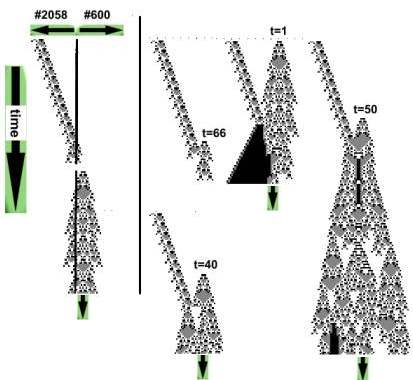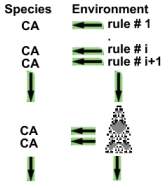 |
Infection
In this experiment we follow the adventures of the #2058 spore which was born in he previous experiment. The universe is divided into two regions. The first is controlled by rule #2058, and the second by rule #600 In the first history, the spore existed in the region controlled by rule #2058. Now it attempts to enter the region controlled by rule #600. The black line marks the boundary between the regions. The spore's attempt to cross fails, and it dies. The history below it depicts an evolving CA#600. Some of its substance may cross the border and remains unharmed.
 |
In the next history the spore attempts to save itself
by infecting a young CA#600 (living across the border) which was planted
66 days after the experiment started. Both CAs died after infection.
In the following history, the spore infected a mature CA#600, and transformed
it into a nectar producing species, which continued living for ever.
In the history below the spore infected a CA600 born 40 days after beginning
of the experiment. It transformed CA#600 into a different species
which did not resemble none of its creators.
The extreme case is illustrated by the last history. When the infected young
CA#600, acquired cancerous
properties, e.g., variation of structure (anisocytosis) with islands
of nectar. It continued evolving for ever.
These experiments illustrate some interesting biological
phenomena:
- The effect of age on the outcome of an infection. A young CA#600
infected dies, while an adult
survives.
- Transduction: by which a virus changes the genetic make up of a
microbe. All infected adults were transduced.
- tumor induction by
RNA retro-viruses, which either cause hyperproliferation, or an overt cancer
Evolution
This experiment illustrates also how evolution
might operate. The environment changes the rules and the species has to adapt to it. If it fails,
it will die, like CA#2058 in the
first experiment . In order to survive it has to be creative and choose the correct species for infection.
Yet Darwinists dislike creativity, and maintain that evolution results from adaptation
Environment evolution is not arbitrary. There ought to be some relationship between consecutive rules. Each rule ought to follow its fore runner. Rule transition is also an evolving process, and may be represented by a CA. Each CA state is the rule for the current CA-species. The mechanism will be demonstrated in a future experiment
 |